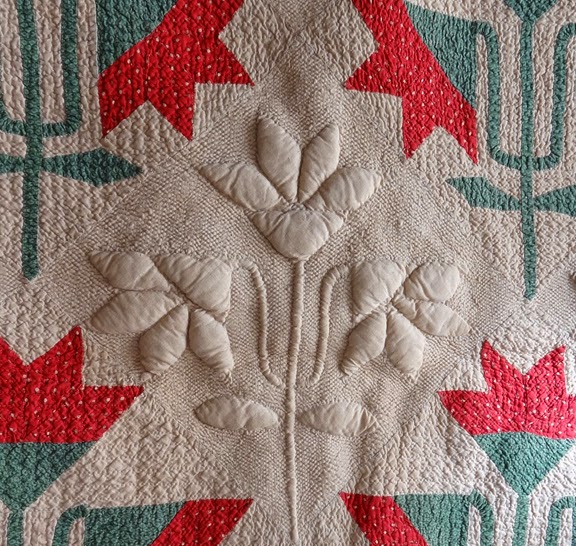Val's white ground chintz repro is a copy of an early
woodblock print.
This week we'll discuss a printing technique rather than a print or color style. Woodblocks are a basic technology for obtaining repeat pattern on fabric.
Woodblocks produced some of the pattern
on this old calico but hand-painting, an even older technology,
may have been the method for obtaining the reds.
An early 19th-century hexagon with fussy-cut figures
from wood block prints. Figures were set far apart,
which made it easy to isolate the floral.
We looked at block technology when we discussed blotch grounds a few weeks ago. One the left, scraps of a woodblock pineapple print with a madder red ground from my collection. The DAR Museum has a quilt with the same fabric in the border at right.
Grapevine medallion by Aberilla Wood Shunk,
DAR collection
See details at the Quilt Index:
Detail from an early cradle quilt
Collection of the Boston Museum of Fine Arts
The simplest woodblock print is a single color on white.
Detail of a contemporary madder block print by Graham Keegan
Vintage madder block print
Vintage indigo print with white areas reserved by wax,
same process used in batik prints.
But many colors could be obtained.
Added blue and added yellow also make green
Well into the 19th century, printers continued to add extra color by hand with a brush (a technique called penciling.)
A floral trail woodblock.
Four colors, madder red, blue, purple and chocolate brown
Full-chintz was the name for large-scale prints with
red, blue, yellow, green, brown and purple in them
(No purple here).
Printers added detail with blocks stuck with metal pins (picotage)
I'm guessing this is a woodblock print because of the poor registration (figures have color gaps) and the soft edges to the colored areas.
As technology improved, they combined metal plate printing (leaves) with block printing (ground).
Early Cradle quilt from the Robbins Family of Lexington, Massachusetts
Collection of the Boston Museum of Fine Arts
If you are looking to create an early quilt you will want some woodblock copies in your stash.
But what to look for?
Detail of a pocket with block-printed chintz and calico.
Registration exceptionally poor in the calico. Note the overlap in the red and brown figures
1) Soft, fuzzy edges to the figures rather than the sharp edges obtained with roller or cylinder printing.
Cylinder print about 1830= Sharp edges
Vintage woodblock print with poor registration in the red
and no sharpness.
2) Simple figures
Reproduction: Collections for a Cause: Community
3) For small prints: a good proportion of background space between the figures.
Paniers Fleurs from French General, reproduction print
3) Crude printing but....
You really can't find poor registration in repros today. Printers take too much pride in their work to do accurate copies of inaccurate woodblocks.
Vintage star from Cyndi's collection at Busy Thimble
Look for medium-size prints as well as large chintzes and small calicoes.
Not all wood block prints are crude however.
Swatch 1790s
This neat stripe is from American printer Archibald Rowen's mill book of samples at the Winterthur Museum. It's a well-done little print, evidence that post-Revolutionary American printworks could produce fabric to rival the French and English.
http://museumblog.winterthur.org/2015/04/01/the-adventures-of-archibald-hamilton-rowan-textile-manufacturer-on-the-banks-of-the-brandywine/
Reproductions
Old Glory by Nancy Gere
The obvious blotch grounds are good repros.
Froncie Quinn's In the Time of Toile
reproduced a block print with a net-like ground.
This isn't a fancy-machine ground done with a metal roller, but a fancy ground probably produced with some kind of a block.
Here's an original version on the cover of Linda Eaton's Printed Textiles.
Judy Severson used the mustard yellow version of Time of Toile
as a border on her star medallion.
Den Haan & Wagenmakers.
The Dutch source for excellent woodblock repros.
See Val's block at the top of the page.
You need small prints too. Woodblocks were excellent at producing these.
7 Brothers from my Lately Arrived From London
Repro block by Becky Brown. She also fussy cut
a simple rose print.
These little sprigs set foulard-style are good too: Simple figures set
in a lot of background space. The yellow from Circa 1825 from In the Beginning,
the pink from my Lately Arrived From London. There are no fancy
backgrounds or shading.
Quilt dated 1822 with a typical wood block calico
The basic figures with little detail are often widely spaced in a half-drop repeat (foulard) set, which
makes them rather spotty.
Feeling Chintzy by Minay Sirois (Reproduction)
That early taste for widely spaced figures makes for a good reproduction. If you want an accurate early look you want spotty prints.
King George III, reproduction pattern
by Sue Ambrose.
This reproduction in accurate Georgian-British
style owes a lot to the many small block-printed-style designs.
What to Do with Your Stack of Stars?
Alternate Darks and Lights
Sawtooth Star by Diana McClun and Laura Nownes
64 stars finishing to 6" = 48" x 48" quilt
One More Thing About Wood Block Prints
Block-printing is still done by hand in many cultures around the world.
Look for block-printed Indiennes (Indian-style prints).
And Japanese Katazome prints
A few pieces of these true woodblocks can give an early look to your stars.
Repro star by Bettina Havig
Two-color print, simple florals, figures spaced widely
See More of Graham Keegan's work here:


















































VKBRQU0bWSQ!~~60_57.jpg)





































































































.jpg)














































.jpg)









BOmFsyDKbg~~60_3.jpg)




























































































.jpg)





































b0YJiBw~~_3.jpg)


















































zG!3g~~60_57.jpg)












.jpg)















.jpg)

